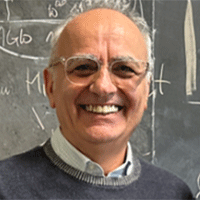
Professor Erasmo Carrera
Politecnico di Torino
Presenting in Track 7: Dynamics, Vibration & Control
Presentation Title: Vibrations of Loaded Structures Accounting for Geometrical Nonlinear Effects and CUF Beam/Plate/Shell Finite Elements Analysis
Abstract: Nonlinear phenomena dominate many engineering problems in various fields. At least one of the three main nonlinearities is often involved: geometrical (stability), physical (material nonlinearities) and unknown boundary condition (contact, impact). Finite Element Methods is by decades the most suitable computational method for both linear and nonlinear problems. Linear problems consist of one-shot analysis, nonlinear ones require multi-shot analysis. This simple fact is the most significant distinction between linear and nonlinear analysis; that is the approximation, e.g. errors in linear analysis, could propagate in a multi-shot case. Therefore, in order to solve in a suitable manner nonlinear problems very efficient "as a whole" numerical models are required. It is a well know fact that assumption of classical beam, plate and shell theories often lead to solutions that could deviate significantly from the exact ones. On the other hand, the use of simplified nonlinear relations (such as von Ka'rma'n approximations) could lead to large errors to detect the correct solutions when the equilibrium path is far from the undeformed configurations.
In recent years, the author and co-workers have successfully introduced and extended the Carrera Unified Formulation, CUF, which is a hierarchical framework to develop any theory of structures for beams, plates and shells including laminated structures and multifield loadings. These have been extended and applied to various nonlinear problems with excellent and unique accuracy. FEs applications have been developed extensively. It has been shown that such accuracy could be only achieved by the use of solid-3D Finite Elements if commercial software is referred to, nevertheless, the computation costs of 3D analysis could become prohibitive. This talk shortly overview some of the most interesting problems solved by CUF: buckling and post-buckling of thin-walled structures, plasticity, progressive failure in laminates, low-velocity impact. The main focus is the nonlinear vibration problems of loaded structures in the very large displacement/rotation equilibrium states. The extraordinary advantages of CUF usage with respect to other models will be made clearly evident. Particular attention will be given to the application to stability analysis in both linearized and nonlinear cases, via the so-called vibration-correlation technique (VCT).
Biography: Erasmo Carrera graduated in Aeronautics in 1986 and in Space Engineering in 1988 at the Politecnico di Torino. He obtained his Phd in Aerospace Engineering in 1991 in the framework of a joint PhD programme between the Politecnico di Milano, Politecnico di Torino and the Università di Pisa. He became Assistant professor in 1992, Associate Professor (2000) and Full Professor (2010) at the Politecnico di Torino.
Dr. Carrera has been visiting professor at the University of Stuttgart, Virginia Tech, Supmeca, CRP Tudor, RMIT. As HiCi Scientist Carrera became member of Distinguished Professor Committee of King Abdulaziz University, and since 2019 Honorary Professor at Prince Mohammad Bin Fahd University, Al-Khobar.
He has been tutor of about 500 Bachelor and Master Theses and about 50 PhDs. His research topics cover: composite materials, nonlinear problems and the stability of structures, vibrations of continuous systems, rotor and nonlinear dynamics, contact mechanics, multibody dynamics, finite elements, path following methods in nonlinear FE analysis, meshless methods, unconventional lifting systems, smart structures, thermal stress for coupled and uncoupled problems, multifield interaction, aeroelasticity, panel flutter, wind blades, advanced theories for beams, plates and shells, mixed variational methods; zig-zag, mixed and layer-wise modelings for multilayered beams plates and shells.
Carrera has introduced the Unified Formulation, or CUF (Carrera Unifed Formulation), as a tool to establish a new framework in which to develop theories of beams, plates and shells for metallic and composite multilayered structures loaded by mechanical, thermal electrical and magnetic loadings. CUF permits any expansion of the unknown variables over the thickness/cross-section domain to be handled in a compact manner via a few fundamental nuclei FNs whose forms do not depend on the order of the used expansion or on the used base functions. Three CUF outcome are the Best Theory Diagram (BTD), the Component Wise (CW) and node dependent kinematic NDK Finite Elements.
Carrera has been author and coauthor of about 800 papers on the above topics, six recent books. Carrera's papers have had more than 30000 citations with h-index=80. Carrera has been recipient of various 'best paper award', including the JN Reddy Medal. He has been responsible for various national and international research contracts.
Due to his international reputation, Carrera has held Invited plenary talks in international conferences. Dr. Carrera serves as Associate Editor for many journals. Hi is founder and Editor-in-Chief of Advances in Aircraft and Spacecraft Science, Editor-in-Chief of Mechanics of Advanced Materials Structures and Section Editor of JSV.
He is Senior Member of AIAA and ASME. He has been elected National President of A.I.D.A.A. for 2018-2022. Professor Carrera is member of the Accademia delle Science di Torino, which was founded in 1757 by L. Lagrange. Member of International Academy of Astronautics (IAA) and of the Academy de L'Air et l'Espace AAE.
Professor Carrera has been Highly Cited Researchers (Top 100 Scientist) by Thompson Reuters in the two Sections: Engineering and Materials. He has been confirmed HiCI in 2015 in the Section Engineering. The only aerospace Engineering worldwide. Due to his scientific outcoming professor Carrera has been recently awarded by the President of Italian Republic, as 'Honoray Commendator'. It consist of one of the highest award in Italy and it has been given to only 73 Italian Scientists from 2003.